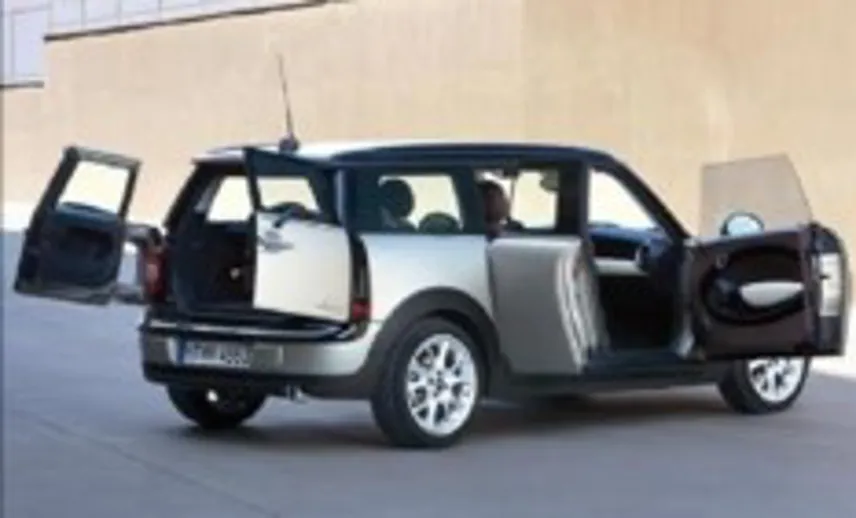Review
 |
 |
 |
As the most successful new car launch of the past decade, the MINI obviously has had a lot going for it.
It drives like a go-kart, has that saccharine styling that makes people want to mother it, is built beautifully, can be personalised like almost no other car and has residual values that beat the most desirable brands.
So all in all, it’s the teacher’s pet – if it wasn’t for that one major flaw. And that flaw is space, or rather the lack of it. Put two adults in the front of a MINI and the rest are in the queue for the bus.
But MINI/BMW has finally addressed this with what is to be called the Clubman.
Exactly what it is though, is a little hard to say. It’s a five-door hatch, or possibly an estate. MINI likes to call it a shooting brake.
It has five doors, but they’re not all where you would expect them to be. Two at the front are as expected, but then there are two at the boot end, opening out sideways with a hydraulic swoosh, and one on the right-hand side of the body. This is a little “suicide door” opening backwards, like the Mazda RX-8’s, with the handle on the inside.
However, the door remains on the right in both right and left-hand drive models, which means a rear passenger exiting on the traffic side for UK models. MINI claims it would have been too expensive to switch it for right- hand drive markets.
There are echos of the wooden frames that adorned the Clubmans and Travellers of the 1960s and 70s with frames around the C-pillar and rear doors but these have been brought up to date and are finished in metallic grey.
The roof is new too, with a surfboard-like side profile, especially where it pokes over the rear of the car.
The Clubman has an 8cm longer wheelbase than the standard car while the body is 24cm longer, with much more overhang behind the back wheels.
What this has done is increase bootspace to 260 litres with the rear seats in place – which is still not exactly cavernous – while improving legroom by the same 8cm gleaned from the wheelbase.
Again this area, known in MINI circles as the “lounge”, isn’t exceptional in space terms, but it does at least give those in the back a fighting chance of walking again after a trip.
Of course, all this extra metal means extra mass (around 80kg more than the standard car), while the longer wheelbase and changes in weight distribution could spell disaster to MINI’s position as a hoot to drive.
Engineers strengthened roll bars front and rear as well as stiffened the springs and dampers because, they reasoned, this car was likely to be carrying heavier loads and they wanted to retain the handling characteristics.
As a precaution, all cars also come with Dynamic Stability Control so even if it’s loaded to the hilt, it is still fun and safe to drive.
It also continues that other MINI tradition of being rather expensive at the front end, with a price premium over the equivalent standard car of £1,250, which is quite a jump: even estate versions of premium models tend to be £1,000-£1,200 more.
Prices start at £14,235 for the Cooper, £15,400 for the Cooper D and £17,210 for the Cooper S but, as usual, all require a decent amount of investment in options – even air conditioning is extra – to bring them up to the equipment levels of rivals.
The Clubman will come with three engines: the 175bhp turbocharged Cooper S, normally aspirated 120bhp Cooper and a 110bhp diesel engine with 109g/km of CO2 and a combined fuel economy figure of 68.9mpg.
In the MINI, the diesel model has never been a big seller and it’s still only predicted to take up 5% of total volume, but things may be slightly different with the Clubman because the type of buyer might shift ever so subtly into one who is more practical, and therefore cost-conscious.
It is estimated it will account for around 20% of all sales, which seems a surprisingly high number for a car that while not without its charms, certainly plays the unique card strongly.
As for residual values, CAP predicts much the same stupendous retained value as the hatch – keeping more than half its value after three years/60,000 miles –suggesting it thinks there will be plenty of buyers wanting the MINI charm and the extra space.
There’s also a decent chance that it will do more fleet business than the hatch, as the extra space will make it more appealing for company car drivers, although it is still likely to be a stronger retail proposition.
Behind the wheel
The Clubman is lugging a whole adult person as extra weight with it, as well as having a longer wheelbase, and the fear is that the MINI magic could have gone from The Great Stupendo to Paul Daniels in one niche-marketed damp squib.
But the Clubman is very agreeable to drive.
While it retains the MINI’s ability to flit about, the longer wheelbase has softened out the ride comfort.
The only car on test was the top-of-the-range Cooper S with optional front differential lock to really haul it out of tight corners hard, but the fluidity of the chassis and the feeling of stability are what impressed most.
Sitting behind the wheel, nothing has changed, but in the back it is certainly more spacious.
In fact, those extra eight centimetres make a marked difference. There is space for four adults to sit comfortably, which might not seem the most glorious of triumphs but is a first for a MINI.
The suicide door also makes it easy to get in and out of although there’s an issue when you are parked close to another car.
Because the front door needs to be open to open the suicide door, you create a triangle between the two and the car’s body which, when they can’t be opened fully, creates a strange little prison for rear passengers. The only option is to crawl out the left hand side as in a traditional MINI.
Verdict
This car is the biggest challenge the all-conquering MINI brand has had. The hatch and convertible felt right from the start, but the Clubman is oddly styled and quirkily packaged, although I really like it. But it engenders very personal tastes. Will buyers find that endearing or annoying?
Fact file
| Model: | Cooper | Cooper D | Cooper S | |||
| Max power (bhp/rpm): | 120/6,000 | 110/4,000 | 175/5,500 | |||
| Max torque (lb-ft/rpm): | 118/4,250 | 192/2,000 | 192/5,000 | |||
| Max speed (mph): | 125 | 120 | 139 | |||
| 0-62mph (secs): | 9.8 | 10.4 | 7.6 | |||
| Fuel consumption (mpg): | 51.4 | 68.9 | 44.8 | |||
| CO2 emissions (g/km): | 132 | 109 | 150 | |||
| On sale: | November | |||||
| Prices: | £14,235 | £15,400 | £17,210 | |||














